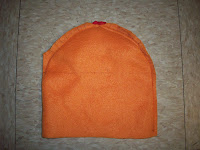Now that we've made our
patterns, it's time to start sewing our shirts!
The first step is to lay out your pattern pieces on your material. Thrifty chick that I am, I decided to use some old shirts that I had laying around. Buddy was very excited and wanted to help!
Since I needed to cut out two of each pattern piece (a front and a back and two sleeves) and since each piece needed to be placed on a fold, I simply folded over the shirts and pinned my patterns on the edges.
Since I used old shirts I was able to line up the bottom edges of the pattern pieces with the already finished edges of the shirts. This way I was able to save myself the trouble of hemming the shirt and cuffing the sleeves later on. If you also choose to do this, just remember to subtract whatever seam allowance you had added to the pattern pieces for the bottom shirt edge and the sleeve cuffs... otherwise you'll have a long shirt with sleeves that are too long! A simple and temporary way to subtract the seam allowance is to fold the edge of the pattern piece.
Alright, everybody got your pieces cut out? You should have a back, and front, and two sleeves. Now is a good time to add a design or applique to your shirt while the pieces are flat. I added an orange stripe to the font of this shirt just for fun.
Now lay your sleeves upside-down on top of the front of your shirt. The "right" sides of the sleeves and front should be facing each other. Pin along the shoulder edge and then sew. Now is probably a good time to mention that when machine sewing with "knit" fabrics such as T-shirt material you will want to use a needle designed for knit fabrics. Normal machine needles have a tendency to slice through fabric threads... which causes runs and unsightly unraveling in knit materials.
Once you finish sewing the sleeves to the front of the shirt, sew the back of the shirt on in the same way. You should end up with a cross-shaped looking garment with all of the "right" sides facing up and all of the "wrong" sides underneath.
And now for the one tricky part: sewing on the collar! It took me a couple tries to get this right, so be patient with yourself too.
First you need to determine the circumference of the collar. One way to do this is to measure around the opening for the collar that was created when you sewed the sleeves onto the front and back of the shirt. It is also a good idea to measure the head of whomever will be wearing this shirt to make sure that they will be able to get their head through the collar. (One of the first shirts I made Buddy had this problem! I couldn't get it over his head!)
Perhaps the best material for collar-making is "ribbing." Although you could use regular T-shirt material, ribbing has a bit more stretch to it and lays a little nicer. The orange tank top that I cut up for this shirt was made of ribbing, so I was in luck!
Once you determine the circumference of the collar, add two seam allowances (for example, if you use 3/8" seam allowances, add 3/4") and cut that from a two or three inch wide strip of material.
Sew the strip into a loop and then fold and press it in half lengthwise.
Now with the right sides of your shirt facing up, pin the folded strip around the collar opening with the open edge towards the center.
Go ahead and sew around the collar. It is helpful to use at least a 1/2" seam allowance here. (You'll see why in a minute!) Also, I found that using a slightly larger stitch length and a looser tension on my machine kept the collar from getting all stretched out as I sewed it.
Once it's sewn, you're going to flip the open edge of the collar underneath the shirt so that the folded edge is now towards the center. To keep the collar in place and to keep that open edge tucked away, sew around the shirt just below the collar. If you gave yourself at least a 1/2" seam allowance, it will be easier to secure that open edge!
Alright, the collar is sewn in! Whew!
Now fold the shirt inside out and pin up the sides of the shirt and the bottoms of the sleeves. Go ahead and sew them up!
After sewing up the sides, make a tiny snip at the armpit almost to the seam. Believe it or not, this little snip is the difference between a nice-looking flat armpit seam and a wonky, bunched-up armpit seam.
Because I used old T-shirts with existing hems I didn't have to finish the bottom of my shirt or cuff the sleeves. Otherwise, that would be your last step.
Finally, turn your creation right-side out and enjoy!
Buddy certainly enjoys his!
























































